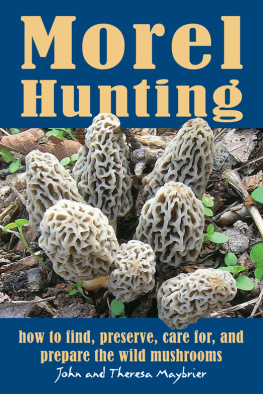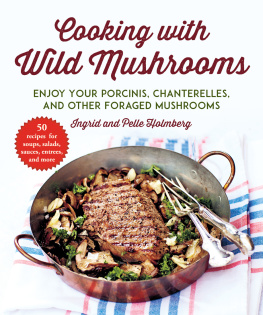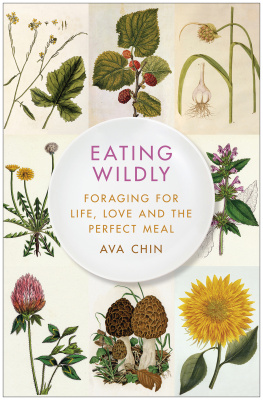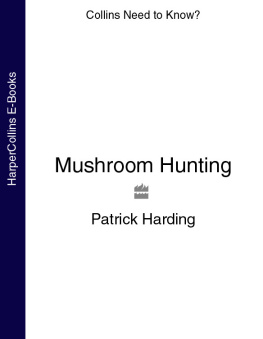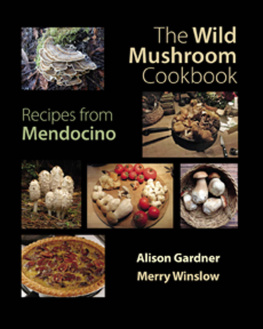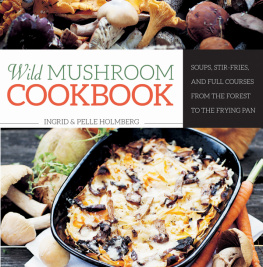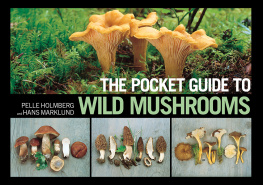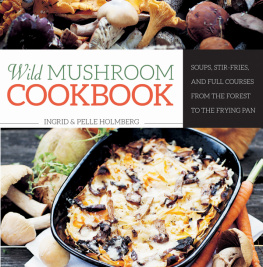John Maybrier - Morel Hunting: How to Find, Preserve, Care for, and Prepare the Wild Mushrooms
Here you can read online John Maybrier - Morel Hunting: How to Find, Preserve, Care for, and Prepare the Wild Mushrooms full text of the book (entire story) in english for free. Download pdf and epub, get meaning, cover and reviews about this ebook. year: 2011, publisher: Stackpole Books, genre: Children. Description of the work, (preface) as well as reviews are available. Best literature library LitArk.com created for fans of good reading and offers a wide selection of genres:
Romance novel
Science fiction
Adventure
Detective
Science
History
Home and family
Prose
Art
Politics
Computer
Non-fiction
Religion
Business
Children
Humor
Choose a favorite category and find really read worthwhile books. Enjoy immersion in the world of imagination, feel the emotions of the characters or learn something new for yourself, make an fascinating discovery.
- Book:Morel Hunting: How to Find, Preserve, Care for, and Prepare the Wild Mushrooms
- Author:
- Publisher:Stackpole Books
- Genre:
- Year:2011
- Rating:5 / 5
- Favourites:Add to favourites
- Your mark:
- 100
- 1
- 2
- 3
- 4
- 5
Morel Hunting: How to Find, Preserve, Care for, and Prepare the Wild Mushrooms: summary, description and annotation
We offer to read an annotation, description, summary or preface (depends on what the author of the book "Morel Hunting: How to Find, Preserve, Care for, and Prepare the Wild Mushrooms" wrote himself). If you haven't found the necessary information about the book — write in the comments, we will try to find it.
John Maybrier: author's other books
Who wrote Morel Hunting: How to Find, Preserve, Care for, and Prepare the Wild Mushrooms? Find out the surname, the name of the author of the book and a list of all author's works by series.
Morel Hunting: How to Find, Preserve, Care for, and Prepare the Wild Mushrooms — read online for free the complete book (whole text) full work
Below is the text of the book, divided by pages. System saving the place of the last page read, allows you to conveniently read the book "Morel Hunting: How to Find, Preserve, Care for, and Prepare the Wild Mushrooms" online for free, without having to search again every time where you left off. Put a bookmark, and you can go to the page where you finished reading at any time.
Font size:
Interval:
Bookmark:

Do you want more mushrooms? Do you?
For our dear friend, Larry Lonik, The Mushroom Man
Copyright 2004, 2010 by John and Theresa Maybrier
Published by
STACKPOLE BOOKS
5067 Ritter Road
Mechanicsburg, PA 17055
www.stackpolebooks.com
All rights reserved, including the right to reproduce this book or portions thereof in any form or by any means, electronic or mechanical, including photocopying, recording, or by any information storage and retrieval system, without permission in writing from the publisher. All inquiries should be addressed to Stackpole Books, 5067 Ritter Road, Mechanicsburg, Pennsylvania 17055.
Printed in China
Chapter 7 was published in modified form in Adventure Sports Outdoors magazine in August 2004.
10 9 8 7 6 5 4 3 2 1
Library of Congress Cataloging-in-Publication Data
Maybrier, John.
Morel hunting / John and Theresa Maybrier.
p. cm.
Includes index.
ISBN-13: 978-0-8117-0834-0 (pbk.)
ISBN-10: 0-8117-0834-9 (pbk.)
eISBN-13: 978-0-8117-4429-4
1. Morels. 2. Cooking (Morels) I. Maybrier, Theresa. II. Title.
QK623.M65M39 2010
641.358dc22
2010040715
Introduction
F ew things are as exciting and enjoyable as mushroom hunting. We have introduced hundreds of people to mushroom hunting, and to date, no one has said it wasnt the sport for them. We have heard squeaks and squeals, yips and hollers. The joy of the hunt is the enjoyment of the woods in the springtime, the thrill of finding the elusive morel, and the pure pleasure of eating the bounty of the hunt.
There is an old saying: give a man a fish, feed him a dinner; teach a man to fish and he can feed himself for life. We feel the same way about teaching someone to hunt for morels. Once you get a bug for foraging youll likely expand into foraging for other types of mushrooms and who knows, maybe wild berries, nuts, and wild herbs.
The morel mushroom is the safest, most recognizable mushroom in the woods. This book is designed to introduce you to the joy of foraging for morels, how to find and identify them, and then what to do with them once you find them.
Our experience as guides on group mushroom hunts, along with our personal experience as chasers (people who follow mushrooms north as the season moves north) and commercial pickers, and our travels on the sport show circuit have given us the background to do seminars, teach classes, and write this book. In this book we want to share what we know about the growing habits of morels and how to hunt them so that everyone can be better at the sport of mushroom hunting, as well as preserving and preparing mushrooms.
PART I
The Sport of Morel Hunting
T he sport of morel hunting is a springtime ritual for more than fifteen million mushroom hunters. Thats more than deer and turkey hunters combined. Yet there is very little marketing to the mushroom hunter, little knowledge of the rules and regulations for hunting public grounds; nor are there many books like this one educating people about how to hunt, preserve, and prepare mushrooms properly. The lack of knowledge has built up the mystique of mushroom hunting, partly because many people are afraid of mushroom poisoning (fungophobia), and partly because mushroom hunters dont want to share their experiences because the season is short. Fifty years ago morel mushrooms were abundant. However, the population of morels is down substantially, and current hunters want all the mushrooms for themselves.

A morel outside and inside.
Morels are the safest mushroom to hunt. They are the only springtime mushrooms in the woods that look like sea sponges (thus called sponge mushrooms) and have hollow stems that become the cap. Not only are morels the easiest to identify, but they also are the safest to pick and eat. For over fifty years morels have been harvested in the wild for worldwide distribution. There have been no recorded deaths associated with the morel mushroom.
This book will help anyone learn how to find, identify, and collect morels. Well not only teach you where and how to find morels and identify them, but also how to preserve them to eat year round and how to prepare them properly.
All fungus has bacteria in it, making it hard to digest. Wild mushrooms should always be cooked properly so that they are more digestible. Basic cooking methods and some great recipes are in
Keep in mind, the first time you try any new variety of mushroom, try a small amount. If you have no adverse reaction within twenty four hours, enjoy!

All in a days work!
CHAPTER 1
Identifying Morels
T here are five basic varieties of morels. All five varieties of this springtime treat share three simple characteristics. First, it looks like a sea sponge; second, it is hollow; and third, if you cut the morel in half from top to bottom, the cut line (outline) of the morel is continuous. If not, it is not a morel. The half-cap morel has the same outline, but part of the cap extends beyond the point where the cap and stem meet. The false morel or Verpa mushroom, which resembles the true half-cap morel, has a cotton-like substance inside the stem stock, and the cap joins the stem up inside the cap with a very definable junction. The cap can be easily knocked off, and the two parts seem very distinct.
Morels show up in the spring in the following order: The first variety is Morchella antigusticeps, commonly referred to as the black morel, which appears when daytime temperatures are in the high fifties to low sixties for four or five days after a full week without a freeze. Then Morchella semilibera, commonly known as half-cap or half-free, shows up when daytime temperatures rise to the low to mid sixties. Morchella deliciosa, the gray morel, appears when daytime temperatures reach the high sixties. Morchella esculenta, the yellow morel, appears when daytime highs reach the low seventies, and finally the big foot or Morchella crassipes appears when the daily high temperatures reach the high seventies. The season ends when the daytime temperatures are in the eighties for a few days. The last three varieties are referred to as the whites. Each of the varieties has a short window of growth relating to its temperature zone. Our experience is that everyone has their favorite variety to hunt and eat.
VARIETIES OF MORELS
We used to think our friend Larry Lonik liked the black morels best because he was from Michigan where black morels are more abundant, but he really liked them so much because their flavor is deeper and meatier, and they are more aromatic than the other varieties. Besides flavor, our favorite thing about the black morels is that they grow in patches and they signify the beginning of the morel mushroom season. When you find a black morel take time to look around. This variety is usually out in the open at the onset of the season. Usually the only groundcover is leaves; black morels should be easy to see. However, like the other varieties they sometimes can be harder to see. Often, the shadows of leaves look like black morels. When the black morels are taller later in the season (which can be as short as a week depending on how quickly the temperatures rise) they stand up like little witchs caps on the ground. As the season progresses, the black morels can be found in the open, near trees and under or near the shade of evergreen trees if it gets too warm for them. Look for any woodsy area with good leaf litter..
Font size:
Interval:
Bookmark:
Similar books «Morel Hunting: How to Find, Preserve, Care for, and Prepare the Wild Mushrooms»
Look at similar books to Morel Hunting: How to Find, Preserve, Care for, and Prepare the Wild Mushrooms. We have selected literature similar in name and meaning in the hope of providing readers with more options to find new, interesting, not yet read works.
Discussion, reviews of the book Morel Hunting: How to Find, Preserve, Care for, and Prepare the Wild Mushrooms and just readers' own opinions. Leave your comments, write what you think about the work, its meaning or the main characters. Specify what exactly you liked and what you didn't like, and why you think so.

